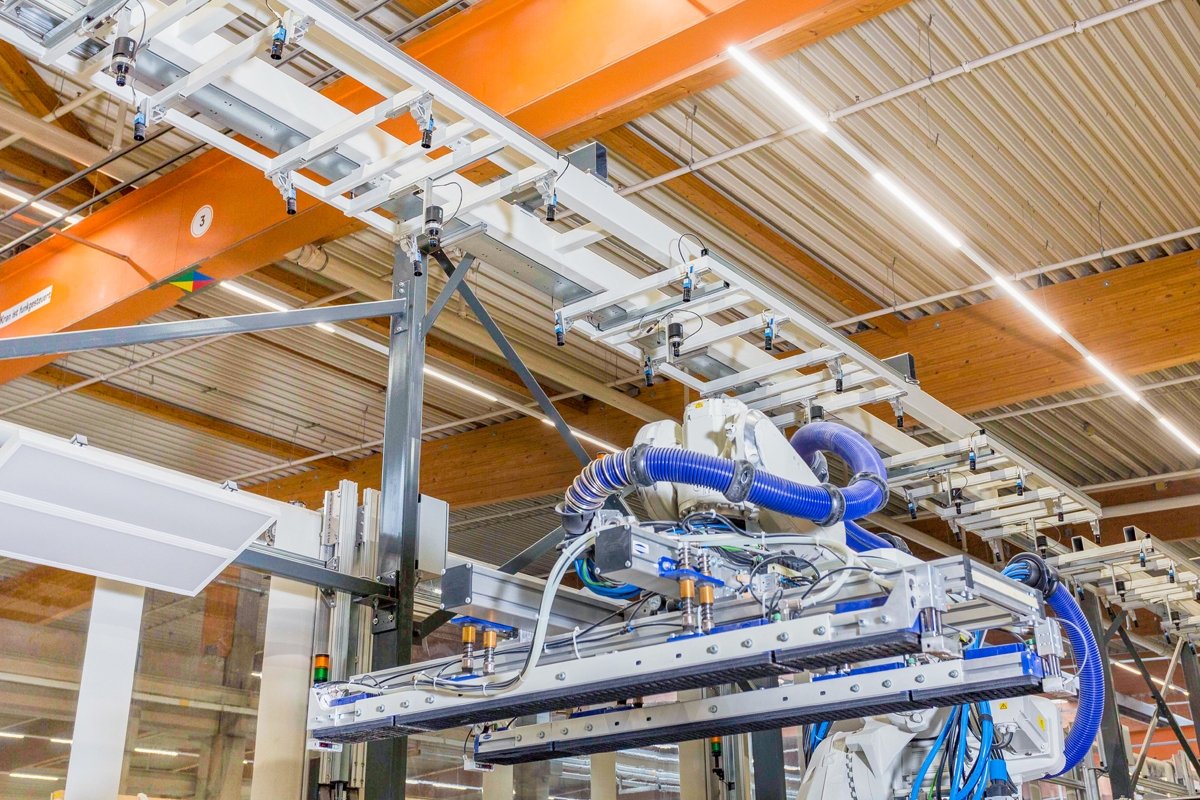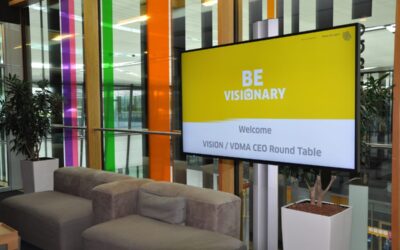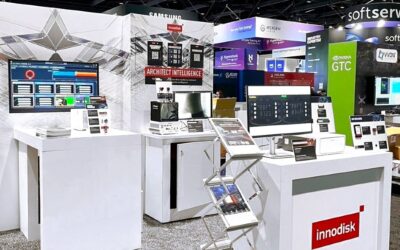BETH Sondermaschinen has developed and implemented a comprehensive plant concept for prefabricated houses, utilising phil-vision’s 3D camera systems. It includes both the semi-automated production of the wooden frameworks and the automated paneling of wall elements.
The core element of the system is the robot cell for automated paneling of wall elements. Up to now, the paneling of wall elements made of timber and plasterboard was carried out by employees on assembly tables in the production line, and the subsequent fastening was done
with hand-operated staplers. The wall elements were then transferred to a buffer system. In the future, a 50-meter-long line with a width of approximately 10 meters will offer maximum flexibility for paneling with standard dimensions and special geometries, including feeding and
transfer to the next production step. Automated paneling is possible for geometries from 80x250mm to 1250x3000mm.
The different sheets are provided lying on stacks, whereby the sheets for one wall element form a coherent stack. A robot with a vacuum gripping system removes the sheets and positions them precisely on the timber frame. The integrated 3D camera system identifies the sheets. Automatic fastening of the two different panel types is performed by the robot using a clamping device.

State-of-the-art camera system and intelligent light system for recognition of part position and orientation
In close consultation with the customer, phil-vision developed a core element of the system, a state-of-the-art machine vision system based on 3D cameras for recognizing the cut-to-size sheets, including recognition software and integration into the overall system: The 3D camera
systems recognize the respective position of the wood-based or plasterboard sheets, while an intelligent light system supports position recognition. The exact position data is immediately processed by software developed by BETH and transferred to the robot, which then takes over the precise paneling.
The solution is based on a system consisting of eight 20MP monochrome cameras with GigE Vision interface and corresponding compact lenses and two pattern projectors mounted above the paneling station. The cameras are combined into four stereo systems, which generate a complete point cloud with just one shot. Subsequent processing is performed on a high-performance industrial PC. The “PK Construct” software solution developed by the customer ensures fast and secure communication between the camera system and the robot.
Every prefabricated house is unique
The challenge for the system is the complexity of the wall elements because each prefabricated house is in some way unique, each tailored to the customer’s wishes. In addition to standard wall elements, there are always special cases with different geometries. Wall length: 800 – 12000 mm, tolerance +/- 10mm Wall height: 1600 – 3000 mm, tolerance +/- 5mm Wall thickness: 80 – 300 mm, tolerance +/-2mm
The dimensional stability of the materials also varies in the range of +/- 3mm. The sheets for one wall element are combined in a stack with up to 70 layers, and several sheets can be in one stack layer. These are not in any fixed order, so it is not possible to process them side by side from left to right on the wall element; instead, the individual panel parts must each be placed in their different positions on the wall element.
Of course, the individual panel parts must not be damaged during transport and positioning. Dimensional tolerances must be taken into account as well. By design, a gap of 3mm is provided between the individual sheets of a panel system, which can be used to compensate for tolerances.
Exact positioning with the aid of 3D camera technology
Exact positioning of the individual sheets is essential because faulty paneling causes the production process to reach a standstill. In order to determine the exact position of the sheets for the gripper system, the sheets are measured with 3D camera systems, and the data obtained gives the absolute position in the coordinate system of the robot cell.
When asked about the main challenges facing the vision system, Patrick Gailer, Managing Director of phil-vision GmbH, replies: “To keep the large system mechanically stable enough for the large measurement volume, is a major challenge for the calibration. Only a few recalibrations per year are required to correct for temperature. In addition, it is difficult to give a high precision position, while at the same time reacting flexibly to components that, due to production-related large variations compared to the models differ quite a bit and can be bent up to three times their height. Additionally, the goal of system development was to provide a system that is significantly less expensive than other high-accuracy 3D scanners currently available on the market.
The system we developed is significantly different from other systems that have been tested. The combination of the short cycle time of 8 seconds, and the large measuring volume of 4.1m³ with an accuracy of well below 1mm, is probably unique on the market. The fact that the image is acquired while the robot is still placing the previously measured sheet means that very fast cycle times are possible. This has now proven itself in series production for over half a year.”

State-of-the-art automation
In the paneling cell, the handling and clamping of the panels on the framing unit is carried out by an industrial robot from ABB, type IRB 6700, on a traversing axis that is over 20m long. The robot is equipped with a SCHUNK changing system in order to be able to switch fully automatically between the suction gripper for picking up the panels and the clamping device.
After the sheets have been placed in the correct position on the framing unit produced in the previous cell, they are fastened with clamps according to the customer’s design specifications. Once again, BETH’s “PK Construct” software is responsible for calculating the optimum travel paths.
Ergonomics, process reliability and flexibility in one system
The result of the BETH Sondermaschinen GmbH project is a highly precise paneling system that also enables efficient cooperation between employees and robots thanks to intelligently designed safety areas. A central, user-friendly cell control system enables the control of individual processes for maximum flexibility in case of necessary intermediate work steps.
It is worth highlighting the small but important details of this system, which has only been possible through close cooperation with FingerHaus staff on site: existing work processes were analysed, improvements identified and a customized automation solution was developed. Whether it is the efficient use of the existing production space, the operability of the robot in individual processes for more flexible cooperation with the workers on the machine or simply the fact that process reliability is improved – with this system, FingerHaus’ production is state-of-the-art and ideally equipped for the future.
Friedrich Köster, Managing Director of BETH Sondermaschinen GmbH summarizes the cooperation with phil-vision in this project as follows: “Due to the essential importance of machine vision for the functionality of the entire plant, we were looking for a powerful partner in this field, which we found in phil-vision. The experienced experts provided us with the best possible advice regarding the feasibility of our idea, carried out extensive tests for us and put together the optimum camera technology for us, which proves itself every day in practical use at our customer FingerHaus.”

About BETH Sondermaschinen GmbH
BETH Sondermaschinen GmbH offers individual machine solutions for industrial woodworking. From individual machines to complex, fully automated systems in the field of window and door production, prefabricated house construction, mullion/transom production and classic
special machine construction, projects of all sizes are implemented. From project planning to service, everything comes from a single source.
The intensive cooperation with Paul Köster GmbH within the Köster Group results in numerous advantages and synergies: 25 years of experience and extensive expertise in woodworking meet current know-how in the areas of design, automation, digitalisation and the latest innovations from the automotive industry.
About phil-vision GmbH
With over 110 years of experience, phil-vision GmbH has been supporting customers in the realisation of sophisticated machine vision applications since 2015. From consulting and feasibility studies to complete system solutions including know-how transfer to the customer, phil-vision is the perfect partner for customers who have an idea but are not sure whether it can be implemented with camera technology.
Read more from MVPro Media here!





